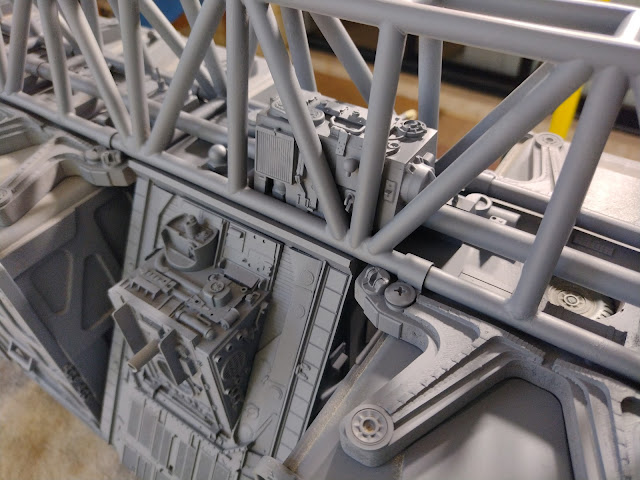I masked up all the areas I was going to leave dark primer grey and sprayed the base colour from a Montana Spray can.
Next I knocked up a graphic in photoshop and cut a couple out of stencil vinyl on a Silhouette Portrait vinyl cutter.

This mask was carefully applied to the wings using masking tape as a transfer film. Added to the stencil was a paper and masking tape barrier which was then sprayed with flat white primer from a can. It did bleed under the mask and I had to touch up the greenish blue to fix it. Some liquid mask was dapped on in spots to chip the edges of the graphic.
The next step was to apply the light blue concentric rings of the design. I initially tried a mask cut out on the vinyl cutter but that proved too problematic. It would not sit down flat over the fully nurnied surface and the bleed would have been out of control. At this point I considered abandoning the stripes but I really wanted to keep them. After a bit of thinking I came up with a more manual solution. I made a jig that located against the rear corner of the hull and had a swinging arm with holes spaced the stripe thickness apart. Swinging the arm I could poke a marker pen through the holes and draw the stripe edge positions on the model. Following the drawn marks I could then place 3mm masking tape along the edges. The thin tape was also relatively easy to poke down into all the grooves and divots in the surface detail to minimise bleed. Normal width masking tape could then be applied between the thin masked lines.


I misted the pale baby blue from a bit of a distance to get a dry spray to try and prevent any bleed under the masking. As it was this particular colour came out pretty dry anyway and so I had no bleed at all. It also resulted in a pretty rough pebbly surface which I eventually rubbed back with a bit of scotch brite scourer.
In theory the black permanent marker could then be removed using Iso Propyl alcohol. While it came off the main hull colour with out any problem it unfortunately got absorbed into the baby blue stripes a bit. This is where the heavy weathering comes to the rescue cause it just blended into the rest of the grime.
Below you can see the result of the stripes with an black and burnt umber mix oil wash applied.
In the picture above I have also applied some acrylic hobby paints to make a bit of colour variation in the panels. I mix in some acrylic medium to make the colours more of a transparent glaze which subtly shifts the underlying colour without being too opaque.
Dry brushing was the applied, white acrylic on the grey areas and a pale green blue on the main hull colour.
The dry brushing was followed up with hand painted chipping on the surface panels using the same pale green blue acrylic paint.
After that I randomly applied a bunch of self adhesive vinyl rectangles in black, white and red. On the strip of colour on the engines I also applied some panels of vinyl in a shade of blue similar to the hull colour. This vinyl was gloss which stood out a bit so I gently sanded the glossy vinyl with 1200 wet and dry and the sprayed that section with some clear flat spray.
Finally here are the photos of the completed model.
This was the inspirational sketch by Jan Buragay (@rags23 on instagram) that kicked off this project...
...and my finished interpretation.
My engines have turned out longer in proportion than the sketch and I have added details like doors and windows.
In general I am pretty happy with the result.
The model is 730mm long ( about 29 inches) 280mm wide and at 1/35 scale.
Thanks for looking.





















































































